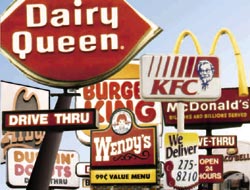Off-Campus Lunch

October 3, 2017
Imagine not being crammed in a tiny cafeteria with 400 other students. Imagine being able to drive off campus and get  Subway or McDonald’s and being able to relax while you eat in peace.
Subway or McDonald’s and being able to relax while you eat in peace.
Milford High School has had a closed campus for many years; no one is allowed to leave the grounds while school is in session without permission.
Closed campus was implemented for the safety and security of students and to cut down on students skipping school. While many students and staff have varying opinions on the issue, they all want a healthy, satisfying, and more peaceful lunch period.
“I’m always open minded when it comes to hearing the perspective from the students, especially on the topic of off-campus lunch,” said Milford High School Principal Kevin Mckenna.
Off campus lunch has been a topic of discussion for years, but students are now more prone to ask questions and engage in the reasoning behind the answer.
“I would rather have students and administration come up with a plan then keep going on like this,” stated senior Samantha Potter.
An enjoyable lunch period is a student’s top concern, while safety is administration’s top concern.
“I think we sit enough during school we should at least be able to sit outside or go off campus to eat decent food,” said Potter. Although Milford is fortunate enough to have school lunch provided for students, it doesn’t always meet the requirements some students need or want.
School food doesn’t always appeal to vegetarians, vegans, or people with allergies and it’s not always the healthiest of choices.
“I won’t eat lunch here because it’s very unhealthy and it’s not nutritious and it’s a little expensive. I bring my own lunch only because I can’t eat here. If it was off campus the I would for sure take that opportunity,” says Potter.
As the survey and students say lunch could have more nutritious options and have more reasonable priced items, but if off campus lunch for students were to be put in action, more students would complain less. The school could potentially save money on food costs as well.
An example of this would be “I am highly allergic to gluten, dairy, and corn, unfortunately that makes my options eating in the cafeteria a lot harder,” said sophomore Alyvia Martinez.
“Safety is our main concern, and as far as liability goes; as a school are responsible for you, your parents trust us to keep you safe. How are we supposed to do that when you leave campus?” asked Dean of Students Shawn Durso.
Milford students are given exactly 30 minutes to eat lunch, which does not include the time it takes to get to the cafeteria, stand in line for five to six minutes and find a seat.Finally, when students are finished, they may have less than 10 minutes to socialize and relax. . When all’s said and done you have no time to really sit and enjoy your food; you have to inhale your food if you want any time to socialize with friends or use the restroom.
Stats show on http://www.latimes.com that kids with longer lunch periods tend to eat 47% of their food and drink 73% of their drinks versus having a shorter lunch period and kids only eating 35% of their food and only drinking 62% of their drinks.
Wanting to know how many people actually ate lunch food, a survey was taken at random to Milford students. Out of 31 people that were randomly selected and surveyed, 23 students drive, and only six people eat the school lunch regularly. That means, 19.3% of students from the survey eat the food regularly and 100% of the students that were surveyed said they would go off campus and be back on time to class.
“I can’t recall a frequent proposal that a student has come up with about this, but your administration team is always able to listen and if you could come up with a manageable plan then people would certainly want to listen,” says Durso.
Any types of ideas would be better than no ideas in this type of situation, let your imagination run wild. In case anyone wanted to try and make ideas for off campus lunch agreements here would be some tips.
“Instead of trying to change the Huron Valley School Board’s mind, present the facts, that’s important, present what other schools are doing, present how this could really work for Milford! Personally, I would get representatives from this school and others, to present these ideas. Make sure that you answer all of these questions and concerns, that’s ideal,” says Mckenna.
While the teachers advocation of safety for students is understable, maybe with a little luck Milford can make this work!